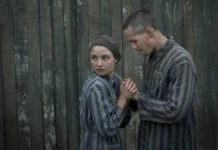
Brothers Harry and Stuart Sauer both enjoyed professional success. Harry Sauer owned an executive recruiting firm for 25 years, sold it and started buying real estate. Stuart Sauer installs accounting software for property management businesses.
But for brothers who were raised by three Holocaust survivors, professional success was never enough. They felt compelled to contribute to organized Jewish life and to show their eight combined children and grandchildren that it was important to do so.
Harry Sauer served as president of his synagogue, Har Zion in Penn Valley, in the early 2000s, while Stuart Sauer just finished a term as president of his, Congregation Beth El in Voorhees, New Jersey.
Their parents, Selig and Erna Sauer, survived several concentration camps, including Auschwitz-Birkenau and Dachau. But after they got to the United States and had their sons in Rochester, New York, Selig Sauer died of cancer. The mother and her sons moved to Philadelphia, where Erna Sauer joined a survivor group and met and married another: Tzvi Bratt.
The brothers would not even be here were it not for their mother’s resourcefulness. Before Yom HaShoah on May 5, they remembered her story.
How She Survived
Erna Sauer spent time in four concentration camps. She was regularly beaten and practically starved to death, according to Harry Sauer.
She had a gold coin, and she gave it to her childhood friend to hide. But when Erna Sauer was selected for the line to the gas chamber instead of the work line, her friend bribed a Nazi guard with the coin. Erna Sauer was switched to the work line.
Earlier in the war, she was hiding with cousins in the basement of a neighbor’s house. To keep the neighbor from turning them in, Erna Sauer retrieved jewelry and money from under the front porch of her family home. The jewelry and money were hidden there by her father.
It worked until she ran out, at which point the neighbor turned her in.
Erna Sauer spent about two-and-a-half years in the camps. But born in 1928, she was young and could make shoes, build bullets and help pave roads. She slept in a bed with five or six other women. In the winter, they huddled together to keep warm.
The Swedish Red Cross liberated her camp in April 1945. The Red Cross then shipped her to Sweden to recover. Erna Sauer was emaciated. She needed to eat.
“They nursed her back to health,” Stuart Sauer said of the Red Cross.
Erna Sauer moved to a city in Sweden called Lund and lived in an apartment with other female survivors. After two years, she got a telegram from her brother.
“I’m alive, and your sister Rose is alive,” Harry Sauer said of the message.

They were living in Straubing, a city in southern Germany. Post-Hitler Germany was friendlier to the Jews than the family’s native Poland, where there was still a lot of antisemitism.
Erna Sauer “couldn’t get on a train fast enough,” Harry Sauer said.
It was in Straubing that she later met Selig Sauer.
How She Met Another Survivor
The brothers don’t know as much about their father’s survival story because he died when they were young. But they do remember that, after he died, they moved to Philadelphia and their mother joined the New Americans Club, a group of survivors.
“They formed such tremendous bonds,” Stuart Sauer said.
They spent the holidays together. Tzvi Bratt had also survived the Holocaust and lost his spouse after having two sons. Bratt fought in the 1948 War of Independence that established the modern state of Israel. He moved to Philadelphia after his wife died because he had a brother here.
On Being Raised by Three Survivors
For a long time, “there was a known recognition that they were all Holocaust survivors, but nobody wanted to talk about it,” Stuart Sauer said.
But around 1975, Holocaust remembrance went mainstream, according to Stuart Sauer. Hebrew schools started to teach about it. Programs and documentaries began airing on TV.
The brothers began to hear bits and pieces, especially when their parents would play cards with their survivor friends. But there was not a direct conversation until “Schindler’s List” came out in 1993.
One year later, Steven Spielberg, the director of “Schindler’s List,” launched the USC Shoah Foundation to record Holocaust survivor stories.
“We said, ‘Mom, we want you to make a video,’” Harry Sauer recalled.
She said no repeatedly. But years later, she said yes. Her boys finally heard her story.
“Judaism was their culture, and it was shattered,” Stuart Sauer said.
“It was shattered temporarily until after the war,” Harry Sauer added.






